Archive for May, 2016
Dream Big, They Said
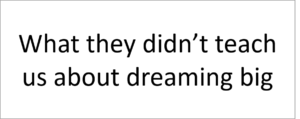 Remember when we were little kids and we were told we could do anything we set our minds to? We heard it mostly in grade school, but also in after-school programs and from parents.
Remember when we were little kids and we were told we could do anything we set our minds to? We heard it mostly in grade school, but also in after-school programs and from parents.
We were told inspiring accounts of people who achieved great things. We learned of career options from astronaut to president and told we could have those jobs. We were taught about Mother Theresa and Martin Luther King Jr and told we too could do big work with a big impact that helped many people.
We were told to dream and work hard. We could do great things in our lives. We just had to make up our minds and go for it.
Teachers and the others – they can’t very well NOT say those things. Where would we be if we hadn’t been told to have dreams and try to reach them?
I wish, though, that we had been taught what to do when things go wrong in our pursuit of our big dreams. And what to do when life squishes our dreams before we even really attempt to achieve them.
I think it happens as early as high school – when we trade in our grand ideas for more practical matters. Our awareness grows. We understand what we hear on the news and its implications in our own lives…jobs and joblessness, natural disasters, war…
There are also timelines to consider. Preparing for the first job out of high school, or attempting to get into college and then deciding what to study. And then graduating and needing a job and a place to live.
After college I wasn’t dreaming much. I enjoyed my life and dove into the beginning of my career, but looking back, I can say my dreams were replaced by goals.
And my goals – at least the biggest two that I accomplished in my adult life so far – didn’t even come from a strong desire within myself to achieve something meaningful.
Instead, they were inspired by obstinacy.
It is true that since college, if not earlier, I vaguely expected to get an advanced degree at some point in my life. However, it wasn’t until I was rejected from a year-long marketing certificate program that I was motivated to get an MBA. My exact thinking was, “Seriously, I was turned down for a certificate? Screw them, I’m getting a master’s degree.” Some rigorous GMAT prep and five years of school later, I had my degree. Ultimately, I was glad I was refused participation in the certificate because it turned out to be a fraction of what I wanted to learn and was capable of achieving.
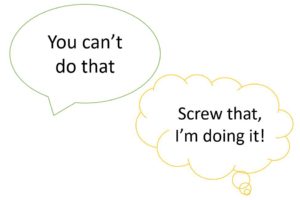 My second example is only slightly different, in that I hadn’t thought about home ownership as a goal at all. I was about to give up my apartment to move to another place with someone when circumstances changed and obstinacy kicked in again.
My second example is only slightly different, in that I hadn’t thought about home ownership as a goal at all. I was about to give up my apartment to move to another place with someone when circumstances changed and obstinacy kicked in again.
I decided I would make housing plans on my own and buy a place instead of renting. I made a budget in excel, put as much as I could into the down payment and fees, and then I owned a home.
I didn’t need to learn to use rejection and setbacks as motivation but I think it should be taught. I hear too many stories from older writers and artists who put down their pens when they were young adults because somebody told them they weren’t talented. It seems like it would be a very useful lesson plan to prepare kids for when they are told no, they can’t, they aren’t good enough, to muster a “screw you” attitude and pursue their art anyway.
Another skill that I wish I had been taught in school is how to channel disappointment into something useful. I get depressed by civic issues of inequity and discrimination and need more than the grade school equivalent of a lemonade stand that raises money for these causes. My stabs at educating myself, speaking up, and seeking out groups to participate in seem the right steps for now, but I was floundering for a long time.
The lemonade stand fundraiser is great to show little kids that they can take initiative and tangibly provide support for causes. But then the cups are put away, the money is donated, and life goes on. What’s missing is sustained effort, and follow-up to see what impact was made. An analysis to determine what about the effort was successful and what can be done to improve. Or how to translate lessons learned into the next effort.
Some of my good friends share this sense of civic-work malaise. We have a sense of being pushed to put our skills and experience to better use. Even people who are working in non-profits or who are on the board of multiple civic groups are unsettled and feel there is more they should be doing. There is a limit to how many action committees a person can reasonably join, so it seems failure to achieve the desired impact is the problem. We’re falling short of our big dreams to make a big impact.
Wouldn’t it be great if we were taught throughout school how to be patient and sustain efforts over a long period of time, even when we don’t see the results we want? I remember being taught about Abe Lincoln’s personal and professional setbacks before he became president. He had business debts that took years to pay off, was a self-taught lawyer, and lost his first attempt to win an Illinois state legislative position.
What isn’t clear is what motivated him to keep pursuing his dreams.
I wonder if he was driven by a belief that he had something to offer people. Maybe he resolved to keep trying, and to look for ways to use his abilities to be of service.
What we do know is that he said yes to opportunities. Clearly he didn’t let fear of failure prevent him from going into business, becoming an attorney, or running for public office. After each misstep, he came back with resilience. Whatever doubts he might have had about his abilities to perform in those professions didn’t stop him from showing up and doing his work.
I didn’t learn these things in school, although I wish I had.
I’ll keep using obstinacy as fuel when people tell me I can’t do something I want to do. I’ll try to be patient with setbacks and keep ahold of my belief that I have something to offer, even when I don’t see progress.
You too, ok? When someone tells you no, go ahead and prove them wrong.
And keep the faith. You’ve got something to offer.
The Coffee Can Method of Getting a Dream Job
 Elizabeth Gilbert tells a story about a woman who dreamed of traveling the world, but was an impoverished single mother. The woman put a single dollar bill in a coffee can every day. As Gilbert tells it, the woman figured that they had so little money that one dollar didn’t make a difference. After many, many years, once the kids were grown, the woman finally had enough money saved to travel on a cargo ship that visited a number of different ports. She sustained her goal for two decades, and achieved it.
Elizabeth Gilbert tells a story about a woman who dreamed of traveling the world, but was an impoverished single mother. The woman put a single dollar bill in a coffee can every day. As Gilbert tells it, the woman figured that they had so little money that one dollar didn’t make a difference. After many, many years, once the kids were grown, the woman finally had enough money saved to travel on a cargo ship that visited a number of different ports. She sustained her goal for two decades, and achieved it.
I like this story. I especially like to remember it when it my goals seem distant and so difficult to achieve – specifically, publishing my self-help book for people that want to quit their jobs. It will happen, someday!
I also like to remember the coffee can story when I think about all of the people who are unhappy in their jobs, who feel stuck and have very real obstacles that make it difficult to quit. Their current jobs have health insurance for their families and the jobs they want do not. Their current jobs pay the rent and the daycare and the jobs they want would not cover those bills. Their current jobs are in the towns where they share custody of their children with their ex-spouses, and the jobs they want are in other parts of the country.
These are real blockers.
Still, getting unblocked is realistic. Saving money is fundamental in creating more choices for work. It can take a long time, and setbacks from unexpected expenses are frustrating. Yet it is possible.
There are other possibilities for getting unstuck, but they too can be long journeys. Doing a “side hustle” is the safest, most risk-adverse way that I know of to launch a new career. However it takes energy and motivation to spend time on a side business before going to a day job in the morning, and to work on it at night and on weekends. Sometimes it might seem worth it, and other times it might seem too exhausting.
I relate to this particular struggle. My drive to complete my book and shop it out to agents and publishers competes with my desire to have downtime and rest. In my case, choosing rest means that it will just take longer to complete my goal.
Hopefully not twenty years.
There are also ways to lessen the pain of the current job while working towards the dream career. Building confidence through honing skills and racking up “wins” by completing projects to the best of abilities helps. Fine-tuning resumes and LinkedIn profiles is a good idea for everyone. Expanding life outside of work to include hobbies, friends and fun is a great way to keep a miserable job from feeling like it is all-consuming.
We hear all the time that “life is short”. But time is relative, so life can also be long. It’s okay if you didn’t start putting money in the coffee can ten years ago. You can start now. You can start any time.
The job you want is there for you, even if it is far enough away that you can’t quite believe it yet.
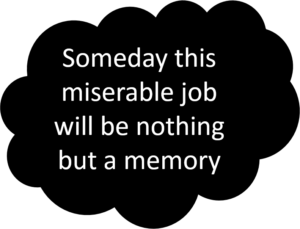
What Makeup Taught Me About Business
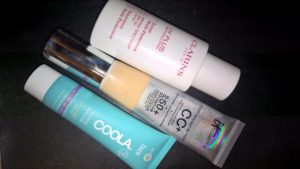 Or an alternate title for this post: My Fake Beauty Blog.
Or an alternate title for this post: My Fake Beauty Blog.
I like makeup. I like learning about new products, talking about them, trying and buying.
I did a great job of limiting the buying part for a couple of years. Then I had a streak of steady paychecks from my consulting work and suddenly the pursuit of the perfect moisturizer seemed like a good hobby. I found it after a long quest through many mediocre creams, oils and balms. It is Peter Thomas Roth’s Mega Rich Intensive Anti-Aging Cellular Crème, which provides hydration for my dry-combination skin longer than any other I’ve tried.
After that I needed a new hobby – like finding the ideal matte plum lip color. Which as it turns out, is Benefit Cosmetic’s Lollitint Cheek & Lip Stain. You see how quickly this gets out of control?
Eventually I reigned it back in.
How?
I did my taxes and my checking account became as empty as my tube of Dior Addict Lipstick in Rock’n Roll 750 that I finally finished. And won’t repurchase because Dior is not worth the hype. The best thing about Dior products is feeling like a snob for using them. Like the time my friend and I got out our powder compacts at the same time and she said her Lancome was about the same as my Dior. I laughed so hard and she said I was a total snob, which I’m laughing about again as I relay it now, as if it was a compliment.
But really, Lancome powder is better than Dior’s. And Too Faced Primed & Poreless Pressed Powder is better than both of them, and is also better than the Cover FX that I’m using now because I wanted to try something new.
Anyway, once again my Sephora problem has vanished just as the dark circles under my eyes vanish when I use Urban Decay’s Naked Skin Color Correcting Fluid.
Now I’ll have to get my makeup at Ulta – ha ha.
Just kidding! Ulta is not completely low-end. Ulta stocks It Cosmetics and Sephora doesn’t.
I just wish Ulta’s emails and circulars weren’t so stark. I hate the incongruence of reading about It Cosmetics’ Your Skin But Better CC Cream with SPF 50+ on a flimsy flyer then spending $38 to buy a tube of it. Which, by the way, although it is branded as a CC Cream, it wears like an unbelievably smooth, full coverage foundation – with SPF 50!
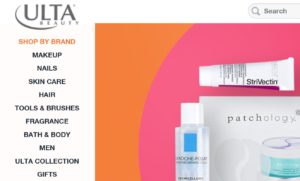
image via www.ulta.com
I also wish Ulta would stop using their orange brand colors as their main color scheme. I would like them to use their trademark orange as an accent and stick with black for the website and marketing materials. Black is the ultimate base color for cosmetic brands because it is clean and sharp and lets the products be the focus.
And…put some highlights and dimension into their flat color blocks that they use for text in their ads. Layering is the CC cream of marketing graphics, people!
I digress. And while digressing, I might as well put on a mask, like GlamGlow’s SUPERMUD Clearing Treatment. It works much better at refining pores than Murad or Origin, which soften the skin but don’t do much else. Masks are a great way to multi-task when you’re working on the computer.
Anyway, I’ve learned a lot about business from being a cosmetics consumer.
This started years ago when I was shopping for a new perfume and didn’t know where to start. The salesperson was savvy and blunt and rolled his eyes when I picked up bottles that weren’t good matches for me. He held up a bottle of Dior’s Poison perfume and asked me who that perfume was meant for. Without even smelling it, I could see that the dark, sculpted bottle was designed to appeal to a more sophisticated woman who was older than I was at that time. The heavy, spicy scent confirmed it.
Now I automatically notice how cosmetic brands and retailers advertise themselves and their products, and think about how that matches to their target audience. That’s a useful marketing skill, but observing and discerning helps in many aspects of business.
Looking at a company’s brand and how I relate to that brand helps to evaluate work opportunities. Can I align with their mission and approach? Am I a good match with their “style” – can I “wear” their brand so that I’m representing their core values in my work?
Similarly, when individual projects are underway, I like to see if they are evolving in the same way the customers’ needs and expectations are evolving.
Another way that I’ve learned about business through makeup is by watching beauty bloggers review cosmetics and give tutorials on YouTube. Did you know that some of them are making big bucks by the ad revenue generated through viewers?
I’m not surprised. They offer value to their “customers” in very specific ways. Viewers can search for particular product reviews or tutorials – like how to color correct. Or, loyally follow their favorite personalities, like Grav3yardgirl, who has more than 6.8 million subscribers.
These bloggers talk to viewers like they’re casually telling friends their opinions of specific products and sharing their tips on techniques. They show appreciation to their viewers for watching. Some of them are get-to-the-point and others are more about entertainment. For a consumer, it is a no-pressure way to get product information before making a buying decision.
So that’s how my interest in makeup taught me to evaluate brands and apply those lessons to my own business projects. But that’s all I’ve got time for now. I’ve got to go wash off my face mask.
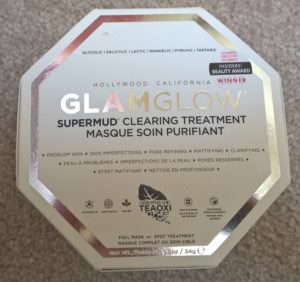

Recent Comments